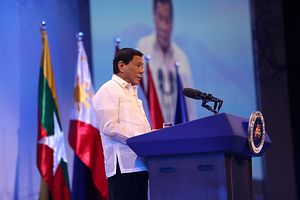On Tuesday, Philippine President Rodrigo Duterte declared martial law in the southern Philippines after violence broke out in Marawi City between Islamic State-linked militants, local police, and the Philippine military. On Tuesday afternoon in Marawi City, the capital of the Philippine province of Lanao Del Sur on the island of Mindanao, armed militants with the Maute Group carried out multiple explosions around the city, with authorities warning all civilians to remain indoors. Fighting in Marawi continued into the night.
Duterte, who left for a four-day state visit to Russia on Monday, made the martial law declaration while in Moscow. Philippine Foreign Secretary Alan Peter Cayetano announced at a press conference in Russia that Duterte would cancel the remainder of his visit and return to Manila early on Wednesday morning. Duterte’s state visit to Russia was expected to result in multiple bilateral agreements, including an agreement on defense cooperation. Cayetano will remain in Russia to carry out Duterte’s scheduled bilateral appointments with Russian officials, including a bilateral meeting on Thursday with Russian President Vladimir Putin.
Critically, Duterte’s declaration of martial law only applies to the southern Philippine island of Mindanao and related smaller islands. Mindanao is the second largest island in the Philippines and is home to multiple insurgencies and militant groups. “As of 10 p.m. Manila time (on Tuesday), he has already declared martial law for the entire island of Mindanao,” Presidential Spokesman Ernesto Abella said of the declaration. “This is possible on the grounds of existence of rebellion because of what is happening in Mindanao,” he added.
The martial law declaration will last for 60 days but it does not appear as if the Philippine government has yet drafted a formal document making the announcement. Duterte’s declaration is not unprecedented; in fact, in 2009, former Philippine President Gloria Macapagal Arroyo declared localized martial law for Maguindanao province in the aftermath of a mass killing in the state by militants. Martial law was lifted just seven days later in that instance.
With Duterte’s declaration for the considerably larger area of Mindanao, concerns about creeping authoritarian rule and extended martial law loom large. Since his inauguration in late-June 2016, Duterte has concerned observers both within and outside the Philippines with his repeated expressions of desire for martial law. In March 2017, Duterte warned of doing just what he did on Tuesday — declaring martial law in Mindanao. Abella, the presidential spokesman, talked down that threat, noting that the “President is not a dictator. The legislative and judiciary are independent from each other and we’re cooperating with them.”
Duterte has also expressed his affinity for former Philippine dictator Ferdinand Marcos, who ruled the Philippines under martial law beginning in 1972. Martial law was lifted in 1981 and Marcos was ultimately overthrown in 1986. With the promulgation of a new constitution in 1987, the conditions under which a Philippine president could impose martial law. The 1987 constitution states that a president may “in case of invasion or rebellion, [or] when the public safety requires it” impose martial law.
For now, any concerns with Duterte’s declaration of martial law will largely stem from his perception as an authoritarian-leaning leader, who has acquired a reputation for defying the rule of law after months of a deadly ‘War on Drugs’ that has claimed more than 3,000 lives, mainly through extrajudicial means. As Arroyo’s precedent demonstrates, a localized declaration of martial law is far from unprecedented in the Philippines post-1986 history and Tuesday’s violence in Marawi City gives the government a degree of constitutional justification. Despite these assurances, however, many Filipinos will no doubt remain uneasy about the implications of an even localized declaration of martial law.
































